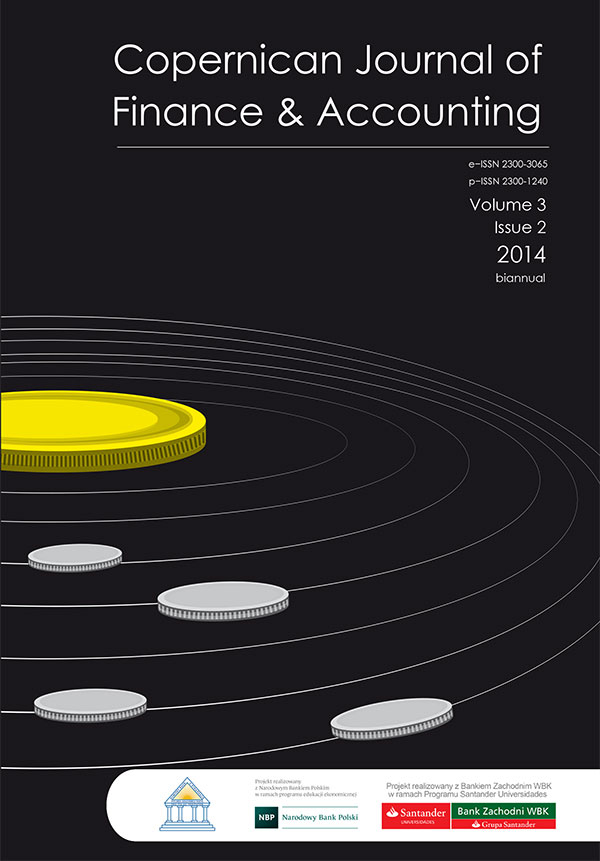IPO Initial Underpricing Anomaly: the Election Gimmick Hypothesis
DOI:
https://doi.org/10.12775/CJFA.2014.025Ключові слова
IPO underpricing, political cycles, stock market anomalies, Warsaw Stock ExchangeАнотація
The relationship between political motivations and underpricing of public offerings of privatized companies is to a great extend unexplored field in the global academic literature. In this paper we offer a new explanation for the IPO underpricing anomaly. We formulate the election gimmick hypothesis, which states that in order to please the voters the treasury may be motivated to leave some money on the table during the IPOs of state-owned enterprises. We test the practical implications of the hypothesis. First we review the previous literature, next we perform empirical research based on a filtered sample of 250 IPOs on the Polish market in years 2005–2013. We examine the abnormal returns in the sample and employing some regression – and simulation- -based methods we examine the sources and variation in underpricing. Our findings suggest that the IPOs of state-owned enterprises are more underpriced than remaining ones and that there is more money left on the table in the months preceding elections.
Посилання
Allen F. & Faulhaber G.R. (1989). Signaling by Underpricing in the IPO Market. Journal of Financial Economics, 23, 303–323. http://dx.doi.org/10.1016/0304-405X(89)90060-3.
Baron D.P. & Holmstrom B. (1980). The Ivestment Banking Contract for New Issues Under Asymmetric Information: Delegation and the Incentive Problem. Journal of Finance, 35, 1115–1138.
Baron D.P. (1982). A Model of the Demand for Investment Banking Advising and Distribution Services for New Issues. Journal of Finance, 37, 955–976.
Benveniste L.M. & Spindt P.A. (1989). How Investment Bankers Determine the Offer Price and Allocation of New Issues. Journal of Financial Economics, 24, 343–361. http://dx.doi.org/10.1016/0304-405X(89)90051-2.
Bhabra H.S. & Pettway R.H. (2003). IPO prospectus information and subsequent performance. Financial Review, 38, 369–397. http://dx.doi.org/10.1111/1540-6288.00051.
Carter R., Dark F. & Singh A. (1998). Underwriter reputation, initial returns, and the long--run performance of IPO stocks. The Journal of Finance, 53, 285–311. http://dx.doi.org/10.1111/0022-1082.104624.
Chalk A.J. & Peavy J.W. (1987). Initial Public Offerings: Daily Returns. Offering Types and the Price Effect. Financial Analysts Journal, 43, 65–69. http://dx.doi.org/10.2469/faj.v43.n5.65.
Clarkson P. M. & Merkley J. (1994). Ex Ante Uncertainty and the Underpricing of Initial Public Offerings: Further Canadian Evidence. Canadian Journal of Administrative Sciences, II, no. 1, 54–67. http://dx.doi.org/10.1111/j.1936-4490.1994.tb00054.x.
Derrien F. (2005). IPO Pricing in Hot Market Conditions: Who Leaves Money on the Table?. Journal of Finance, 60 (1), 487–521. http://dx.doi.org/10.1111/j.1540-6261.2005.00736.x.
Derrien F. & Womack K.L. (2003). Auctions vs. Bookbuilding and the Control of Underpricing in Hot IPO Markets. Review of Financial Studies, 16, 31–61. http://dx.doi.org/10.1093/rfs/16.1.31.
Grinblatt M. & Hwang C.Y. (1989). Signaling and the Pricing of New Issues. Journal of Finance, 44, 393–420. http://dx.doi.org/10.2307/2328596.
Hughes P.J & Thakor A.V. (1992). Litigation Risk, Intermediation and the Underpriccing of Initial Public Offerings. Review of Financial Studies, 5, 709–742. http://dx.doi.org/10.1093/rfs/5.4.709.
Ibbotson R. G., Sindelar J. & Ritter J. (1994). The market’s problems with the pricing of initial public offerings. Journal of Applied Corporate Finance, 7, 66–74. http://dx.doi.org/10.1111/j.1745-6622.1994.tb00395.x.
Ibbotson R.G. & Ritter J.R. (1995), Initial Public Offerings, [in:] Finance, R. A. Jarrow, V. Maksimovic, W. T. Ziemba (eds.), Elsevier, Amsterdam, 993–1016.
Jenkinson T. & Ljungqvist A. (2001), Going Public: The Theory and Evidence on how Companies Raise Equity Finance, Oxford University Press, Oxford.
Kaminski K. & Zaremba A. (2011). IPOs – not so much Money on the Table: The Cost Compensation Hypothesis, Argumenta Oeconomica, available at SSRN: http://ssrn.com/abstract=2349904.
Kiymaz H. (2000). The initial and aftermarket performance of IPO’s in an emerging market: evidence from Istanbul Stock Exchange. Journal of Multinational Financial Management, 10, 213–227.
Loughram T., Ritter J.R. & Rydqvist K. (1994). Initial Public Offerings: International Insights. Pacific-Basin Finance Journal, 2, 165–199.
Loughran T., Ritter J.R. (2002). Why don’t issuers get upset about leaving money on the table in IPOs?. Review of Financial Studies, 15, 413–443.
Lowry M., Schwert W. (2002). IPO market cycles: Bubbles or sequential learning?. Journal
of Finance, 57, 1171–1200.
Mauer D.C. & Senbet W.S. (1992). The Effect of the Secondary Market on the Pricing of Initial Public Offerings: Theory and Evidence. Journal of Financial and Quantitative Analysis, 24, 55–79.
Megginson W.L. & Weiss K.A. (1991). Venture capitalist certification in initial public offerings. Journal of Finance, 46, 879–903.
Ritter J. (2003), Investment banking and securities issuance, [in:] Handbook of the Economics of Finance, G. Constantinides, M. Harris & R. Stulz (eds.), Elsevier, Amsterdam.
Ritter J., Welch I. (2002). A review of IPO activity, pricing, and allocations. The Journal of Finance, 57 (4), 1795–1828.
Rock K. (1986). Why New Issues are Underpriced. Journal of Financial Economics, 15, 187–2012.
Tian L.G. (2011). Regulatory underpricing: Determinants of Chinese extreme IPO returns. Journal of Empirical Finance, 18 (1), 78–90.
Tinic S.M. (1988). Anatomy of Initial Public Offerings of Common Stock. Journal of Finance,
, 789–822.
Welch I. (1989). Seasoned Offerings, Imitation Costs and the Underpricing of Unitial Public Offerings. Journal of Finance, 44, 421–449.
Welch I. (1992). Sequential Sales, Learning and Cascades. Journal of Finance, 47, 695–732.
Yuan J. (2009). Alternative explanations of under-pricing of Chinese initial public offerings, PhD thesis, University of Nottingham.
Downloads
Опубліковано
Як цитувати
Номер
Розділ
Stats
Number of views and downloads: 955
Number of citations: 0



